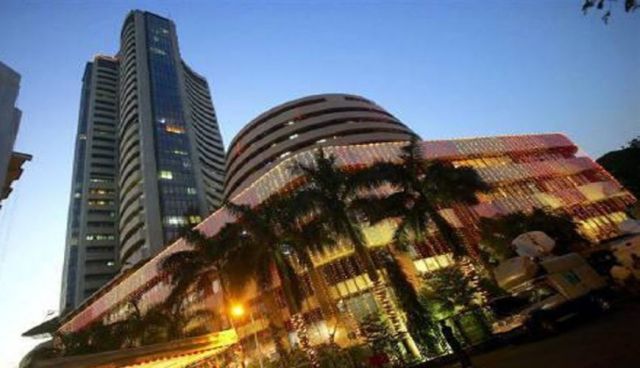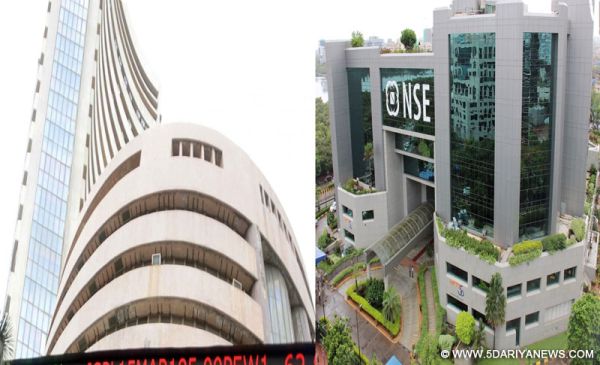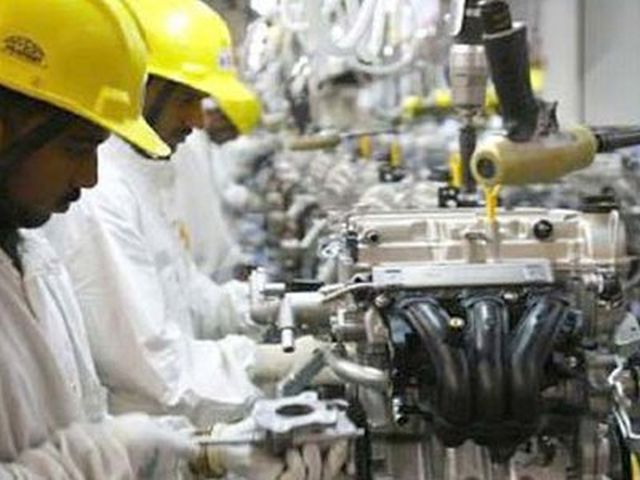
by Editor | May 25, 2021 | Economy, Markets, News
 Mumbai : Higher inflation data and caution ahead of Karnataka election results kept the key Indian equity markets subdued on Monday afternoon.
Mumbai : Higher inflation data and caution ahead of Karnataka election results kept the key Indian equity markets subdued on Monday afternoon.
India’s wholesale inflation rate rose to 3.18 per cent in April from 2.47 per cent in the previous month, official data showed here on Monday.
According to market observers, heavy selling was witnessed in consumer durables, auto and capital goods stocks.
At 1.56 p.m., the wider 50-scrip Nifty of the National Stock Exchange (NSE) was trading at 10,781.85 points — down 24.65 points or 0.23 per cent from the previous close of 10,806.50 points.
The Sensex of the BSE, which opened at 35,555.83 points, was trading at 35,490.26 points (1.56 p.m.), lower by 45.53 points or 0.13 per cent from the previous day’s close at 35,535.79 points.
The Sensex touched a high of 35,642.72 points and a low of 35,456.56 points in the trade so far.
The BSE market breadth was bearish with 1,752 declines and 790 advances.
So far, the major gainers on the BSE were Dr Reddy’s Lab, NTPC, Sun Pharma, Tata Steel and State Bank of India, while Tata Motors (DVR), Tata Motors, Mahindra and Mahindra, ICICI Bank and Yes Bank were the major losers.
On the NSE, the top gainers were NTPC, Dr Reddy’s Lab and State Bank of India. The major losers were Titan, Zee Entertainment and Indusbulls Housing Finance.
—IANS

by Editor | May 25, 2021 | Business, Economy, Large Enterprise, Markets, News
 New Delhi : As manufacturing picked up pace, India’s factory production growth in January at 7.5 per cent doubled over the 3.5 recorded in the same month last year, even as retail inflation eased in February, official data showed on Monday.
New Delhi : As manufacturing picked up pace, India’s factory production growth in January at 7.5 per cent doubled over the 3.5 recorded in the same month last year, even as retail inflation eased in February, official data showed on Monday.
Industry welcomed the “pick-up in growth trajectory” witnessed in the beginning of the calendar year.
The Index of Industrial Production (IIP), however, rose marginally over the 7.1 per cent registered in December 2017, a Central Statistics Office (CSO) release said here.
The cumulative IIP growth for the April-January period of the current fiscal, at 4.1 per cent, was lower than the 5 per cent posted in same period of 2016-17.
In line with the recent trend of recovery in manufacturing, the sector, which constitutes 77.63 per cent of the index, grew by 8.7 per cent during January, as compared to 2.5 per cent in the same month last year.
Retail inflation for February eased down to 4.4 per cent, compared to 5.07 per cent in the previous month. The consumer price-indexed (CPI) inflation was 3.65 per cent in February 2017.
Inflation softened last month mainly on account of cheaper food prices and lower cost for fuel. Inflation rate in the consumer food segment was lower at 3.26 per cent, as compared to 4.7 per cent in January.
The January IIP was also boosted by a higher offtake of consumer and capital goods.
Capital goods output in the month under consideration increased sharply by 14.6 per cent, as against a fall of 0.6 per cent in January last year.
Consumer durables recorded a growth rate of 8 per cent as against a decline of 2 per cent in the same month a year ago.
The mining sector, however, registered negligible growth of 0.1 per cent, as compared to 8.6 per cent rise in January last year.
During January, 16 out of 23 industry groups in the manufacturing sector showed positive growth.
Commenting on the IIP numbers, industry chamber Assocham described these as signs of “an underlying pick-up in the growth trajectory”.
“It would be safe to assume that a lot of advantage has accrued because of the low base effect of the previous year when the growth had plunged following the demonetisation, said Assocham Secretary General D.S. Rawat in a statement.
On retail inflation, “the undercurrent remains biased on the upside, making RBI disinclined towards any rate cut”, he said.
Deloitte India Lead Economist Anis Chakravarty said: “Overall, the latest IIP data points towards signs of economic recovery as the negative effect of the disruptive shocks of last year appear to be on the wane. However, the momentum of the recovery needs to be sustained through effective implementation of the structural and infra related reforms.”
—IANS

by Editor | May 25, 2021 | Business, Commodities, Commodities News, Economy, Markets, News, SMEs

Assocham President Sandeep Jajodia (Left)
New Delhi : A slight easing of food prices helped lower India’s retail inflation in January to 5.07 per cent even as factory production growth slowed somewhat in December to 7.1 per cent, according to official data on Monday.
India Inc lauded the continuing high single-digit recovery in industry as well as the slight fall in inflation.
While retail inflation was 5.21 per cent in December 2017, the Index of Industrial Production (IIP) had grown at an impressive 8.8 per cent in November.
On a year-on-year basis, the consumer price index (CPI) last month was at a much higher level than the 3.17 per cent in January 2017.
The consumer food price index (CFPI) in January stood at 4.58 per cent compared with the 4.85 per cent of December 2017.
As per the data released by the Central Statistics Office (CSO), the sequential slowdown in factory output was mainly on account of lower production in the manufacturing sector.
However, on a year-on-year basis, the manufacturing sector expanded by a healthy 8.4 per cent, while the mining sector’s output inched up by 1.2 per cent and the sub-index of electricity generation increased by 4.4 per cent.
“In terms of industries, 16 out of the 23 industry groups in manufacturing sector have shown positive growth during December 2017 compared with corresponding month of the previous year,” the CSO said.
According to the data, the industry group ‘manufacture of other transport equipment’ has shown the highest growth of 38.3 per cent followed by 33.6 per cent in ‘manufacture of pharmaceuticals, medicinal chemicals and botanical products’ and 29.8 per cent in ‘manufacture of computers, elecronic and optical products’.
Last week, The Reserve Bank of India (RBI) kept its key interest rate unchanged at 6 per cent for the third time in succession at its final bi-monthly monetary policy review of the fiscal, citing upside risks for inflation from rising global crude oil prices and other domestic factors.
The RBI said its decision to keep its repo rate, or short-term lending rate for commercial banks, unchanged is consistent with the neutral stance of the central bank aimed at achieving its median inflation target of 4 per cent.
“We expect headline inflation to be at 5.1 per cent in the fourth quarter (January-March), including the impact of HRA (house rent allowance) to central employees, up from the 4.6 per cent in Q3,” RBI Governor Urjit Patel told reporters in Mumbai after the release of the monetary policy review.
However, the fact that the central bank did not raise the repo rate in the face of hardening inflation as recommended by one of the six monetary policy committee (MPC) members is being considered as an attempt to aid in economic recovery.
Industry chamber Assocham termed the IIP data “a positive sign towards growth cycle of industrial activity in India”.
“However, risks to the Indian economy continues to prevail in the forms of continued uncertainties in the global environment due to geo-political situations, including rising global protectionism could further delay a meaningful recovery of external demand,” said Assocham President Sandeep Jajodia.
“Besides, private investment continues to face several impediments in the form of corporate debt overhang, stress in the financial sector, where (banks’) NPAs (non-performing assets) continue to increase, excess capacity and regulatory and policy challenges,” he added.
“This is the second consecutive month in which IIP has shown high single-digit growth, which is encouraging,” India Ratings and Research (Ind-Ra) Principal Economist Sunil Kumar Sinha said in a statement.
“However, Ind-Ra believes it still early to read much from these numbers as these have been calculated on a low base when industrial output had collapsed due to the impact of demonetisation,” he said.
“Retail inflation came down to 5.07 per cent in January 2018, lower than 5.21 per cent recorded last month, but remained higher than the RBI’s base target value of 4 per cent,” he added.
Rating agency Crisil said that inflation, however, continued to firm up in large parts of the services sectors such as housing, driven by the revision in house rent allowance payments, education and in recreation, amusement and personal care and effects.
“Yet, core inflation, stayed broadly unchanged from the previous month, at around 5.1 per cent in January,” a Crisil release said.
“The industry seems to be shedding away the weight of GST-related glitches behind and trying to get back lost momentum, as both domestic and global growth surge.”
—IANS

by Editor | May 25, 2021 | Economy, Markets, News

Photo: Reuters
New Delhi : Even as retail inflation in India stagnated in September with a marginal drop in the food prices, the Index of Industrial Production (IIP) for August showed that factory output grew 4.3 per cent against the same month last year on the back of robust mining and electricity sector growth, official data showed on Thursday.
According to the Ministry of Statistics and Programme Implementation, September’s consumer price index (CPI) inflation remained static at 3.28 per cent as compared to August.
On a sequential basis, the country’s Consumer Food Price Index (CFPI) dropped to 1.25 per cent during the month under review when compared to 1.52 per cent in August 2017.
However, on a year-on-year (YoY) basis, the country’s September retail inflation was lower than the 4.39 per cent CPI rate reported for the corresponding month of last year.
The drop in retail inflation on a YoY basis was due to a fall in the prices of food items like pulses, eggs and spices. Vegetables in September became costlier by 3.92 per cent, while cereals prices rose by 3.70 per cent.
As against the 4.3 per cent growth in August, manufacturing output in the country in July 2017 had grown marginally by 1.2 per cent as compared to the corresponding month of last year.
As per the new IIP, with the revised base year of 2011-12, factory output had declined by (-)0.1 per cent during June due to a drop in manufacturing, from a rise of 2.80 per cent reported for May this year.
The cumulative growth for the period April-August 2017 was at a much lower 2.2 per cent, over the corresponding period of last year.
Data released by the Central Statistics Office (CSO) showed that the August growth was partly led by a revival in electricity, which grew at 8.3 per cent over the same month last year.
Manufacturing output, which has the maximum weightage in the overall index, grew at 4.3 per cent in August, as against 5.5 per cent during the same month of last year.
Mining output during the month in consideration recorded impressive growth of 9.4 per cent, as compared to the decline in August last year at (-)4.3 per cent.
Among the six use-based classification groups, the output of primary goods grew by 7.1 per cent, consumer non-durables by 6.9 per cent and infrastructure or construction goods by 2.5 per cent.
Both capital goods and consumer durables recovered from last month’s decline to grow in August at 5.4 per cent and 1.6 per cent, respectively.
In contrast, the output of intermediate goods declined by (-)0.2 per cent.
“In terms of industries, 10 out of the 23 industry groups in the manufacturing sector have shown positive growth during the month of August 2017 as compared to the corresponding month of the previous year,” the CSO said.
“The industry group ‘Manufacture of computer, electronic and optical products’ has shown the highest positive growth of 24.9 per cent, followed by 16.5 per cent in ‘Manufacture of pharmaceuticals, medicinal chemical and botanical products. On the other hand, the industry group ‘Manufacture of furniture’ has shown the highest negative growth of (-)16.0 per cent followed by (-)15.1 per cent in ‘Manufacture of tobacco products’ and (-)1.4 percent in ‘Printing and reproduction of recorded media’,” it added.
Industry welcomed the numbers indicating a rebound in industrial growth.
“Rebound in IIP is inspiring after a slowdown in the months of June 2017 and July 2017 vis-a-vis destocking and teething problems of GST,” President PHD Chamber Gopal Jiwarajka said in a statement here.
“Industrial activity shrugged off the weakness of past few months and put up a strong performance in August, suggesting that GST-related disruptions could have somewhat settled,” rating agency CRISIL said in a statement.
“In the months ahead, inflation could see an upside from some bump up in oil prices, and higher household spending led by (i) implementation of farm loan waiver and (ii) an expected upward revision in salary and allowances of state government employees,” it added.
—IANS

by Editor | May 25, 2021 | News, Politics
 Mumbai : The Shiv Sena, which is an alliance partner in both the BJP-led Central and Maharashtra governments, on Satuday launched agitations against the runway fuel price hike and inflation by carrying empty gas cylinders and organising mock funerals of the BJP.
Mumbai : The Shiv Sena, which is an alliance partner in both the BJP-led Central and Maharashtra governments, on Satuday launched agitations against the runway fuel price hike and inflation by carrying empty gas cylinders and organising mock funerals of the BJP.
Thousands of Shiv Sena activists led by ministers, MPs, MLAs, and local unit leaders led the agitations carried out at 12 places all over Mumbai and its suburbs.
Scores of Shiv Sainiks including MPs Arvind Sawant and Anil Desai, several sitting and former legislators and municipal corporators, shakha and gat pramukhs were detained across the city by police.
The Sainiks, many carrying empty gas cylinders or fuel cans, posters and placards, raised deafening slogans attacking the central and state governments headed by Prime Minister Narendra Modi and Chief Minister Devendra Fadnavis respectively.
Thousands of activists including women and youth, chanted slogans of “Narendra Sarkar, Hai Hai, Devendra Sarkar Hai Hai,” “BJP Come to Your Senses, Or Get Out,” “Jai Ram, Shri Ram, BJP Ram Ram,” at various locations catching the attention of the weekend commuters and tourists.
In Bandra, Yuva Sena President Aditya Thackeray reiterated that demonetization has completely failed and multiplied the miseries of the common masses.
The protests were held at Chhatrapati Shivaji Maharaj Terminus, Borivali, Kandivali, Jogeshwari, Dadar, Kurla, Ghatkopar, Bhandup, Chembur, where the speakers alleged a scam in the current high prices of petrol, diesel and gas, and organised a mock funeral of the BJP government in Borivali.
In a statement, the party said the Bharatiya Janata Party is solely responsible for the all round inflation confronting the country and if it failed to bring it under control, the Shiv Sena would launch a nationwide agitation.
The Sena said during the Congress regime, the BJP leaders had launched protests against inflation, but this time their leaders are backing the decisions of Prime Minister Narendra Modi which had hit the masses hard.
This is the second major agitation spearheaded by the Shiv Sena, which is a constituent of the centre’s ruling National Democratic Alliance and a partner in Maharashtra.
Earlier this month, it had organized protests across the state demanding implementation of the total farm loans waiver package announced in June.
Saturday’s agitation programmes were sharply criticized by Mumbai BJP President Ashish Shelar and Leader of Opposition in Legislative Council Dhananjay Munde.
Shelar said those who were elected to power on the strength of Modi are today raising slogans against Modi.
“Its said that when you raise slogans for the death of a living person, he lives a longer life. May Goddess Bhavani give them wisdom during the Navratri,” he said.
Munde said that the Shiv Sena’s protests are “a sham” as it continued to stick to power and when the price hike proposals are made, they remain mute instead of opposing it.
Similar protests were organised by Shiv Sena units in Kolhapur, Thane and other districts in the state as per a call given by party President Uddhav Thackeray last week.
—IANS

 Mumbai : Higher inflation data and caution ahead of Karnataka election results kept the key Indian equity markets subdued on Monday afternoon.
Mumbai : Higher inflation data and caution ahead of Karnataka election results kept the key Indian equity markets subdued on Monday afternoon.



